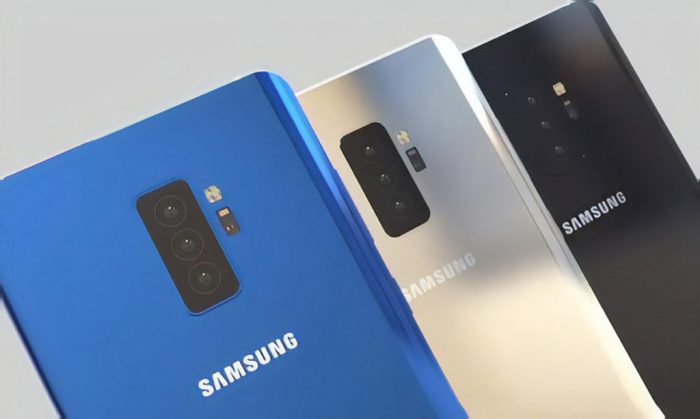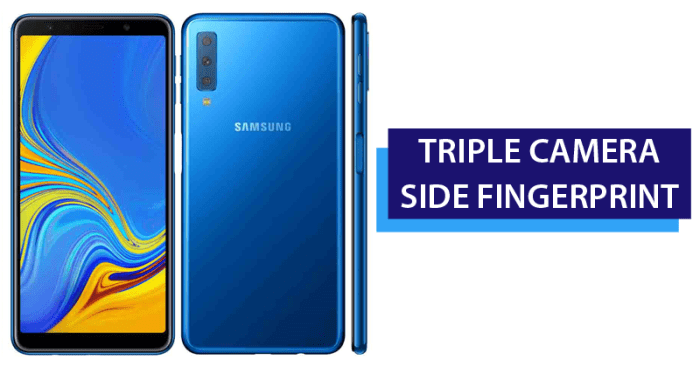Samsung Galaxy A7 Triple Camera Specification
Samsung Galaxy A7 Triple Camera: A Detailed Specification Analysis
Samsung galaxy a7 triple camera specification – The Samsung Galaxy A7, launched in 2018, marked a significant step for Samsung’s mid-range offerings with its pioneering triple-camera setup. This analysis delves into the specifics of this camera system, examining its sensor details, features, image quality, user experience, and comparison with other devices in the same price bracket and within the Samsung Galaxy A series.
Camera Sensor Details, Samsung galaxy a7 triple camera specification
The Galaxy A7’s triple camera system comprised three distinct sensors, each contributing unique capabilities to the overall photographic experience. A detailed breakdown is provided below.
| Camera | Megapixel | Aperture | Sensor Size (estimated) |
|---|---|---|---|
| Main Camera | 24 MP | f/1.7 | 1/2.5″ |
| Ultra-wide Camera | 8 MP | f/2.2 | 1/4″ |
| Depth Sensor | 5 MP | f/2.2 | 1/5″ |
The main camera utilized a phase-detection autofocus (PDAF) system for quick and accurate focusing, while the ultra-wide and depth sensors likely employed contrast detection autofocus. While precise sensor sizes are not always publicly released by manufacturers, estimates based on similar sensors in other devices are used here. Compared to competitors in the same price range at the time of its release, the Galaxy A7 offered a competitive triple-camera setup, although other phones started to offer similar configurations shortly thereafter.
Many phones in this price range offered dual-camera setups, making the triple camera system a notable feature for the Galaxy A7.
| Phone | Main Camera (MP) | Secondary Camera (MP) | Features |
|---|---|---|---|
| Samsung Galaxy A7 | 24 | 8 MP Ultrawide + 5 MP Depth | Triple Camera, PDAF |
| [Competitor Phone Name – Example: Xiaomi Mi A2] | 12 | 20 MP | Dual Camera, PDAF |
Camera Features and Capabilities
The Galaxy A7’s camera app offered a range of features to enhance image capture and processing.
- Optical Image Stabilization (OIS) was included on the main camera to reduce blur in low-light conditions and during hand-held shots.
- A dedicated night mode was implemented to improve low-light performance.
- Video recording capabilities included 1080p at 30fps.
- Shooting modes included Auto, Pro, Panorama, Hyperlapse, and Slow Motion.
Samsung employed advanced image processing algorithms, including HDR (High Dynamic Range) processing, to enhance image detail, dynamic range, and color accuracy. These algorithms optimized the images across various lighting conditions.
- Main Camera: Advantages include high resolution and detail, good low-light performance, and OIS. Disadvantages include a lack of zoom capabilities.
- Ultra-wide Camera: Advantages include capturing wider scenes and perspectives. Disadvantages include lower resolution and potential distortion at the edges.
- Depth Sensor: Advantages include enabling portrait mode with background blur. Disadvantages include limited use outside of portrait mode.
Image and Video Quality
Images captured with the main camera generally showed good detail and dynamic range in well-lit conditions. Colors were accurate and pleasing, although sometimes slightly saturated. Low-light performance was acceptable, though noise became more noticeable in very dark scenes. The ultra-wide camera provided a useful wider field of view, but image quality was noticeably lower than the main camera, with reduced sharpness and detail.
Video recording was satisfactory for casual use but lacked the high bitrates and advanced features found in flagship devices.
The Samsung Galaxy A7’s triple camera system is a notable feature, offering versatile photographic capabilities. To understand the full scope of this device, including its camera specifications alongside other details and pricing, you might find it helpful to check the complete specifications and pricing information available for the phone in Oman; for instance, you can visit this resource for details on the samsung galaxy a7 specification and price in Oman.
Returning to the camera, its impressive capabilities contribute significantly to the overall appeal of the Galaxy A7.
| Lighting Condition | Main Camera | Ultra-wide Camera | Depth Sensor (Portrait Mode) |
|---|---|---|---|
| Bright Sunlight | Excellent detail, accurate colors, good dynamic range | Good field of view, reduced detail and sharpness | Good background blur, detail similar to main camera |
| Low Light | Acceptable detail, increased noise | Significant noise reduction, loss of detail | Blur effect less consistent |
| Indoor | Good detail, slightly warmer color temperature | Reduced detail, noticeable noise | Background blur effect less pronounced |
Camera App Interface and User Experience

Source: co.id
The Galaxy A7’s camera app offered a clean and intuitive interface. Most features were easily accessible, making it user-friendly for casual photographers. The Pro mode allowed for manual control over settings like ISO, shutter speed, and white balance.
One limitation was the lack of RAW image capture, limiting post-processing flexibility. The automatic scene detection could sometimes be overzealous, leading to slightly unnatural image processing in certain situations.
- Open the Camera app.
- Swipe to the “Pro” mode.
- Adjust ISO, Shutter Speed, White Balance, and Focus manually using the on-screen controls.
- Compose your shot and tap the shutter button.
Comparison with other Samsung Galaxy A Series Phones

Source: neoadviser.com
Compared to other phones in the Samsung Galaxy A series at the time, the Galaxy A7’s triple camera system represented a significant upgrade in terms of features and capabilities. While other A-series phones might have offered dual-camera systems with comparable main camera sensors, the addition of the ultrawide and depth sensors differentiated the A7. The price point of the Galaxy A7 reflected this enhanced camera system, offering good value for its features.
| Phone | Main Camera (MP) | Secondary Camera (MP) | Key Features |
|---|---|---|---|
| Samsung Galaxy A7 | 24 | 8 MP Ultrawide + 5 MP Depth | Triple Camera, PDAF, OIS |
| Samsung Galaxy A5 (2018) | 16 | 8 MP | Dual Camera, PDAF |
| Samsung Galaxy A3 (2018) | 13 | None | Single Camera |
Popular Questions: Samsung Galaxy A7 Triple Camera Specification
Does the Samsung Galaxy A7’s triple camera have optical image stabilization (OIS)?
The specifics depend on the exact model of the Galaxy A7. Some models may include OIS on the main lens, while others might not. Check the specifications of your specific model.
Can I shoot 4K video with the Galaxy A7’s triple camera?
Again, this depends on the specific Galaxy A7 model. Many models support 4K video recording, but confirmation through the device’s specifications is necessary.
What type of video stabilization does the Galaxy A7 offer?
The Galaxy A7 typically offers digital video stabilization, potentially supplemented by OIS on certain models for the main camera. Check your device’s specifications for details.
How does the Galaxy A7’s camera perform in extreme low-light conditions?
Low-light performance varies, but generally, the Galaxy A7’s camera produces usable images in low light. However, image quality may degrade compared to higher-end devices with larger sensors or superior low-light processing.





















